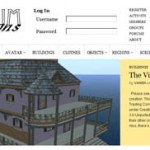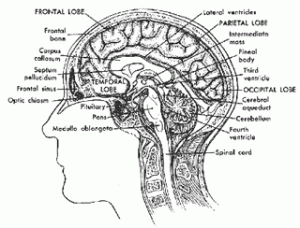Posts tagged constructionism
Undersea Observatory for OpenSim
20I’m close to finishing an underwater simulation in OpenSim to help teach students about marine biology. I’ve been working on it for a couple weeks now, and it’s been interesting and fun to create. In this sim, students become underwater explorers. They board a submarine and take a trip to an underwater lab, which contains a classroom, observation rooms, and exhibits about marine life.
There’s two missions students will undergo. The first is to explore the ocean. After an orientation, students put on a deep sea diving suit and go out and walk around on the ocean floor, and participate in a scavenger hunt to locate, identify, and photograph different biological specimens using the viewer’s snapshot tool. The second mission involves the students creating their own posters about marine wildlife which are then added to the virtual world for the benefit of future visitors. Adventurous students may even be given the ability to texturize, script, and build their own undersea animals. This way, the sim will continue to build on itself as more students use it, and later visitors will enjoy the effort students have put into it. Since I hope to use this Underwater Observatory as part of a larger virtual world system in our school district at a later date, I believe it’s important to use a constructionist approach when designing our educational sims, where students are the main content creators rather than the teachers. Our teachers don’t have the time to create elaborate regions, so we need to encourage students to “Leave it better than you found it!”
 The amazing thing is most of this has been created with freebies. OpenSim has a constantly growing repertoire of good, free content available on the web, which I was able to use. For example, the undersea building itself was created with Tube City. Much of the plant life and some furniture is from Linda Kellie’s collection, and some other components are taken from Universal Campus. There are other pieces from OpenSim Creations, too, and a lot of the details I created myself, such as the lights, the diving suit, the fish swimming around, and the squid. There are some other little easter eggs as well, such as a treasure chest and a shipwreck which the students may come across, and the squid will [harmlessly] follow around anyone who comes within 20 meters.
The amazing thing is most of this has been created with freebies. OpenSim has a constantly growing repertoire of good, free content available on the web, which I was able to use. For example, the undersea building itself was created with Tube City. Much of the plant life and some furniture is from Linda Kellie’s collection, and some other components are taken from Universal Campus. There are other pieces from OpenSim Creations, too, and a lot of the details I created myself, such as the lights, the diving suit, the fish swimming around, and the squid. There are some other little easter eggs as well, such as a treasure chest and a shipwreck which the students may come across, and the squid will [harmlessly] follow around anyone who comes within 20 meters.
I’ve been trying to get Ferd Frederix’s blue whale to work in OpenSim, too, but have been having limited success. Apparently sculpties can’t use the llMoveToTarget() function in OpenSim yet. But normally this would be one of the other reasons OpenSim is such a great choice as an educational virtual world: there are thousands of free LSL scripts for Second Life, and most of them work quite well in OpenSim. Since teachers and students may not have the time to become master scripters, there’s often a script for anything they need that they can just “plug in” to what they create. There’s also plenty of tutorials to help those interested learn how to do it.
There’s still a few things I want to add, and I’d like to fill out more of the rooms because some of them feel a little empty. I still haven’t created a decent submarine to take students to the lab. I was originally going to use Garry’s Beaumont’s fantastic Submarine Nebuchadnezzar, but I’m taking a crack at building my own. Vehicle support is limited in OpenSim due to the physics engine, but I think I can come up with something that works decently enough.
As soon as the sim is finished, I’ll post the OAR files for download here.
UPDATE: 2012-02-27 – I’ve thrown up a few more photos of the work, including the vehicles created for the sim. The Deep Sea ATV is quite fun, but needs a more open space to really go wild. To reach the observatory I ended up deciding to give each student their own “personal submarine” that works as an attachable vehicle, rather than a single giant submarine to take everyone there. I did this for a couple reasons. Although I’m packaging this sim as one region, for my own usage I’m going to plan on everyone traveling across a couple underwater regions to get to the observatory. Physical vehicles can’t cross regions, and I don’t want to force megaregions on the OAR, so an attachable vehicle was the best solution. Crossing multiple regions to get to the sim will help make the descent a little longer to build the anticipation, and help mask the fact I had to raise the sim’s water level higher than the rest of the grid. Plus it’ll be cool to see a fleet of mini-submarines swimming around.
I’m extremely close to being finished now, and have just a few things left to accomplish: Making sure my jellyfishes and squid stay within their boundaries, figuring out why my jellyfishes keep falling (even though their buoyancy should be set to keep them afloat), preventing the squid from flopping around wildly whenever it follows an avatar, and adding videos and informational material to the kiosks in the lobby.
Learning Styles and Constructionism
1 Do your students have different learning styles? Many teachers have probably heard by now that some students are “visual” learners, others “auditory,” and the rest “kinesthetic.” Or perhaps you’ve heard that some people are “left-brained” which makes them creative, while others are “right-brained” which makes them analytical.
Do your students have different learning styles? Many teachers have probably heard by now that some students are “visual” learners, others “auditory,” and the rest “kinesthetic.” Or perhaps you’ve heard that some people are “left-brained” which makes them creative, while others are “right-brained” which makes them analytical.
I’ll admit, I’m not sure I ever accepted across-the-board categorizations such as these. Derribo & Howard (2007) seem inclined to agree, and take it a step further. They argue that there are no reliable instruments to determine or measure learning styles, and that there is no substantial evidence that students’ learning improves when the teacher understands their alleged learning styles. They advocate focusing on learning strategies instead. One key point the authors make is that there is such an abundance of theoretical perspectives and proposed learning instruments that it negates the effectiveness of using learning styles at all. The authors also reference some studies which demonstrate matching learners to styles simply does not lead to more effective learning.
The problem I see with the article is that Derribo & Howard use a narrow scope of scholarship to demonstrate their point, and ignore other studies. They even go so far as to poison the well by writing, “An instructor may argue that he or she has found . . . studies [which support learning styles]. The problem is that most of these investigations are poorly designed” (p. 106).
However, I can see how some readers may misinterpret the authors’ intentions. They are not proposing everyone learns the same way. They are not falling into the trap of assuming that a lack of evidence is evidence against learning styles. What they are suggesting is that trying to categorize learners into neatly-fitted slots may stifle teachers’ willingness to experiment with new learning strategies, and cause teachers to be reluctant to engage students in ways the students don’t necessarily prefer. They note that “students simply may not benefit from certain instructional approaches whether they like them or not” (p. 106). “The problem,” they write, “is simply that instructors have not learned that their teaching styles are not appropriate for a small percentage of students” (p. 107). Questioning whether our categorical associations are correct or incorrect is not the same as saying we shouldn’t categorize at all, and from the article, I don’t think the authors are suggesting any categorizations are necessarily false or misleading. Just that we haven’t figured out the right way to do it yet, and that our time could be spent on better pursuits to engage students.
The ultimate message is good advice for any teacher. Think outside the box, and don’t assume that you sufficiently understand your students’ unique learning needs, because they may surprise you. Good teaching is an endlessly, richly complex field of study, and a teacher should always focus on improving his or her instructional knowledge, techniques, approaches, and strategies.
I’ve been poring over articles about constructivist theories and how they influence educational games, since I’ve been writing a research paper on the topic. It’s quite a fascinating body of literature, and I’ve discovered I sympathize the most with a constructivist approach to learning tasks, though my preference does depend on the situation and context. For learning that can be accomplished by directly involving students and making them active participants in the learning process, constructivist approaches are generally favorable, as they provide opportunities to work in collaborative, often technology-enhanced environments, which is great preparation for entering the 21st century workforce. A proper constructivist approach also provides ample opportunity for reflection during the learning process, which I believe is a seriously needed aspect in our day of “memorize-this-to-pass-the-final-exam” style of teaching.
In Stager (2007), the author describes a “branch” of constructivism called constructionism. Constructionism is an extension of constructivism, with some notable differences. Mainly, while constructivism outlines that learning consists of building knowledge structures, constructionism describes the applied practice of the constructing as creating something tangible and shareable. One criticism of constructivism from the constructionist perspsective is that constructivism provides the means by which knowledge is formed, but fails to provide a context. Indeed, any constructivist approach should include a context, and constructionism is an approach that makes sure this happens.
 The author describes a specific instance in which a constructionist learning environment enabled at-risk students to find ways to learn material they would normally have struggled to grasp, and engaged them by directly involving them in the learning process. The students were given tasks to accomplish, and created machines and robotics with LEGO MINDSTORMS bricks to accomplish those tasks. An example may be students were to create a vehicle which could ascend a specific steep incline. During the process, the students would learn that their major stumbling blocks were natural principles like friction, gravity, structural flaws, and lack of force. Through their trial-and-error experiments, these principles became more than just abstract concepts, but actual obstacles they had to understand, address, and overcome.
The author describes a specific instance in which a constructionist learning environment enabled at-risk students to find ways to learn material they would normally have struggled to grasp, and engaged them by directly involving them in the learning process. The students were given tasks to accomplish, and created machines and robotics with LEGO MINDSTORMS bricks to accomplish those tasks. An example may be students were to create a vehicle which could ascend a specific steep incline. During the process, the students would learn that their major stumbling blocks were natural principles like friction, gravity, structural flaws, and lack of force. Through their trial-and-error experiments, these principles became more than just abstract concepts, but actual obstacles they had to understand, address, and overcome.
I would suggest that constructionism, with its heavy emphasis on technology usage, is an approach well-suited for “digital natives,” or students who are familiar and comfortable with emerging technology, having grown up with it their entire lives. The example of the LEGO MINDSTORMS vehicles could also be accomplished in an appropriate simulation, which is quite relevant as far as educational game design is concerned. Constructionism is also suitable for teaching playwriting, video production, music composition, graphic design, character animation, woodworking, newspaper production, and other instructional tasks in which students produce artifacts.
Maybe it’s just my “learning style,” but I certainly understand the value of not just learning by doing, but learning by doing and producing. As an undergraduate Computer Science student, I took a number of Unix classes. Yet when I entered a career in which I actually had to apply the knowledge, I was at a loss. It wasn’t until I started creating functioning systems, such as a network infrastructure, web server setup, or backup script, did any of the knowledge make sense. Being given a chance to accomplish tasks while I learned was a far more effective learning experience.
References
Derribo, M. H., & Howard, K. (2007). Advice about the use of learning styles: A major myth in education. Journal of College Reading and Learning, 37(2), 101-109.
Stager, G. S. (2001). Constructionism as a high-tech intervention strategy for at-risk learners. Paper delivered at National Educational Computing Conference, Building on the Future, July 25-27, 2001, Chicago, IL.




















